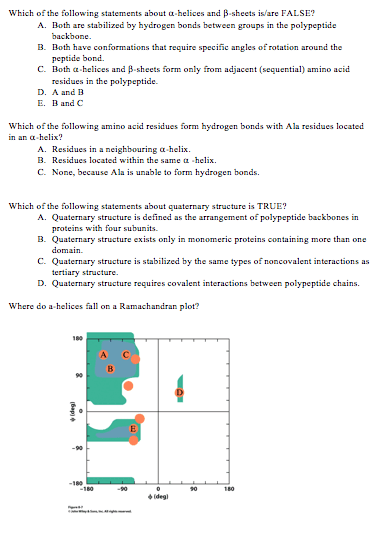Protein Structure
a.Different function of proteins and examples:
b. Protein building blocks:
1. atomic composition of building block:
2. "parts" or "functional groups" of the building block:
c. Importance of side chain (R group):
d. Hydrophobic amino acids characteristics:
e. Hydrophilic amino acids characteristics:
f. Charged amino acids characteristics
Copy and complete the table below regarding the characteristics and which groups in the polypeptide interact together at each structural level of the protein.
| | characteristics | groups interacting |
| Primary structure | | | |
| Secondary structure | | | |
| Tertiary structure | | | |
| Quartenary structure | | | |
Value: 2
Choose the correct statement(s). You may choose more than one answer.
[mark all correct answers]
a. Proteins are the building blocks of amino acids.
b. Enzymes are a type of protein.
c. Quartenary structure consists of two or more polypeptide chains interacting.
d. Amino acids are made of carbon, hydrogen, nitrogen and phosphorus.
e. The primary structure of a protein is formed due to the interaction of side groups.
Value: 3
Put the following statements regarding the structural levels of a protein formation in the correct order.
Below is a sequence of events. Place them in the order they should occur, number 1 being the first item. Select the step number from the drop down next to each item.
Items to order:
1. Individual amino acids are bonded together via peptide bonds.
2. Two or more polypeptide chains interact via bonds.
3. Hydrogen bonds form between neighboring amino acids within a polypeptide chain allowing the chain to coil or form pleated sheets.
4. Side groups (R) of the individual amino acids interact with each other allowing the protein to assume its three dimensional shape.
Value:4
Put the following statements regarding the structural levels of a protein formation in the correct order
| Individual amino acids are bonded together via peptide bonds. | 1 2 3 4 |
| Two or more polypeptide chains interact via bonds. | 1 2 3 4 |
| Hydrogen bonds form between neighboring amino acids within a polypeptide chain allowing the chain to coil or form pleated sheets. | 1 2 3 4 |
| Side groups (R) of the individual amino acids interact with each other allowing the protein to assume its three dimensional shape. | 1 2 3 4 |
Value: 5
Hydrophobic amino acids will be found _______________.
a. In the interior (inner core) of a protein, away from the watery environment.
b. in the interior of a plasma membrane.
c. Both A and B
d. Neither
Value: 6
A protein's function is defined by ____________.
a. enzymatic reactions
b. it's shape.
c. chain of nucleotides.
d. the presence of carbon and hydrogen.
Value: 7
Which of the following is NOT considered a protein function?
a. transport of substances across membrane
b. enzymatic reactions
c. provides structural support
d. carries genetic information



